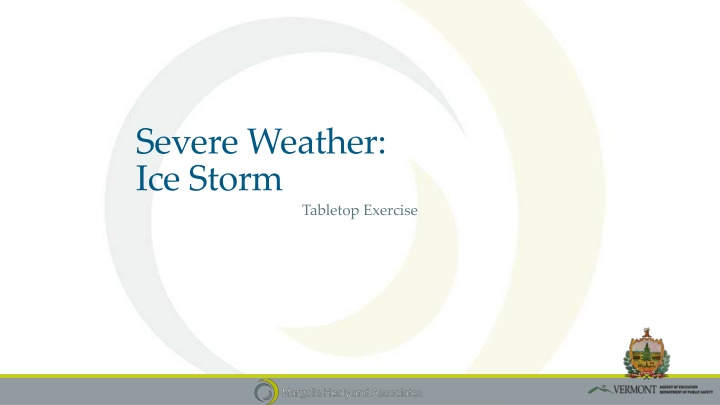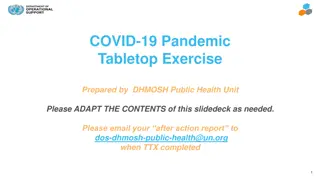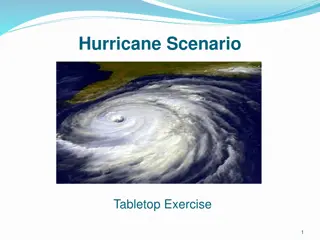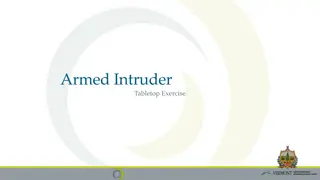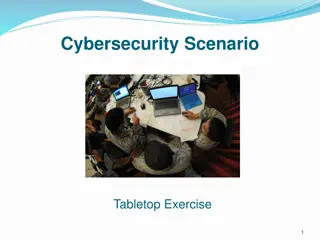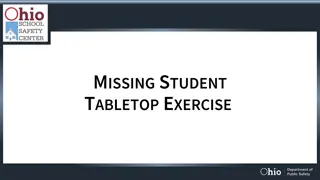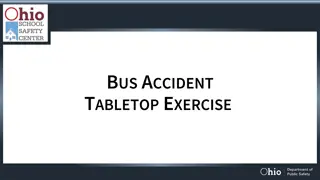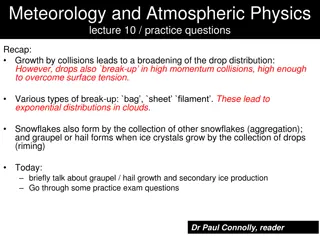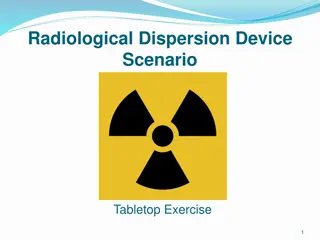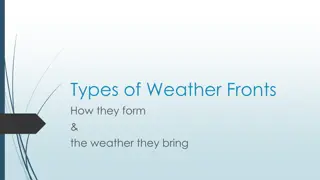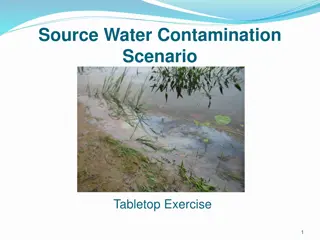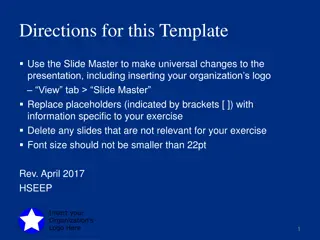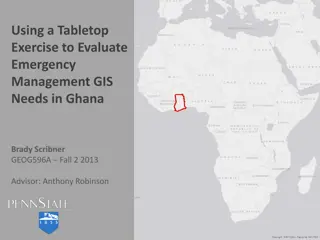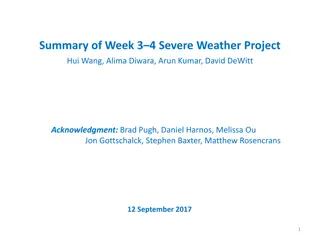Severe Weather Ice Storm Tabletop Exercise Overview
This tabletop exercise focuses on testing plans and coordination for severe weather events, specifically ice storms. Participants will assess roles, responsibilities, and response capabilities related to evacuation, emergency response, and recovery efforts. The exercise aims to strengthen partnerships, identify areas for improvement, and develop corrective action plans.
Download Presentation

Please find below an Image/Link to download the presentation.
The content on the website is provided AS IS for your information and personal use only. It may not be sold, licensed, or shared on other websites without obtaining consent from the author.If you encounter any issues during the download, it is possible that the publisher has removed the file from their server.
You are allowed to download the files provided on this website for personal or commercial use, subject to the condition that they are used lawfully. All files are the property of their respective owners.
The content on the website is provided AS IS for your information and personal use only. It may not be sold, licensed, or shared on other websites without obtaining consent from the author.
E N D
Presentation Transcript
Severe Weather: Ice Storm Tabletop Exercise
Exercise Agenda Welcome and Introductions Housekeeping Exercise Overview Goals Rules Objectives/Core Capabilities Assumptions and Artificialities Roles and Responsibilities Schedule Structure Scenario-Driven Exercise Facilitated Discussion in Four Modules Hot Wash Closing Comments Debrief
Welcome and Introductions Opening Remarks Facilitator Introductions Hosting Agency Participants Exercise Staff Lead Facilitator
Exercise Goals Test plans to prepare for, respond to, and recover from Severe weather related to an Ice Storm. Demonstrate effective coordination of district plans, and actions with school and community partners. Strengthen relationships with our response partners. Identify areas for improvement and develop a corrective action plan.
Objectives and Core Capabilities Assess the roles and responsibilities of the school administration and staff in testing evacuation, emergency response and recovery efforts. Assess the ability to effectively test the notification and activation procedures of the School community Determine strengths and weaknesses in local coordination and integration of response resources. Identify critical issues and potential solutions
Participants Roles and Responsibilities Players: Respond to the situation presented, based on expert knowledge of response procedures, current plans and procedures, and insights derived from training. Facilitator(s): Responsible for moderating and keeping participant discussions focused on exercise objectives and core capabilities, and ensuring relevant issues are explored; provide situational updates and additional information; resolve questions as required.
Exercise Structure A scenario-driven, facilitated discussion-based exercise The exercise is divided in four modules: oModule 1: Initial Response Scenario Background oModule 2: Response Scenario Update #1 oModule 3: Response Scenario Update #2 oModule 4: Recovery Scenario Update #3 Debrief
Rules for Players There are no right or wrong answers/ideas. Varying viewpoints are expected and will be respected. Exercise decisions are not precedent setting. Players are encouraged to consider different approaches and suggest improvements/ Think outside the box.
Ground Rules This is not a test of current capabilities and plans. It is a discussion of probable responses to a hypothetical emergency. The exercise will be an open dialogue. All ideas and input are welcome. One person speaks at a time. The scenario will be accepted as is. However, the facilitator may make modifications as deemed appropriate. No hypothetical resources are available.
Assumptions and Artificialities The exercise is conducted in a no-fault learning environment wherein capabilities, plans, systems and processes will be evaluated. Participants respond to the TTX scenario events and other exercise information from the perspective of their school s current policies, plans, processes and capabilities. The exercise scenario is plausible, and events occur as they are presented in the TTX scenario, allowing for artificialities. All players receive information at the same time.
Exercise Schedule Exercise Logistics and Set-up Registration Welcome and Introductions Exercise Overview Module 1: Initial Response Scenario Background Break Module 2: Response Module 3: Scenario Update Module 4: Recovery Break Hot Wash Closing Comments Debrief
Tabletop Processes A scenario and update statements will be used to generate discussion of probable response actions. Participants will provide situational responses based on established procedures and plans. The Emergency Operations Plan (should be) available for reference. Other than maps and diagrams, no additional materials will be provided. The exercise will conclude with development of action steps needed to support future mitigation and preparedness efforts.
Exercise Guidelines Respond based on your knowledge of your school plans and capabilities. Discuss and present multiple options and possible solutions. Be aware that each phase will not have complete resolution. Any issues that cannot be resolved within a reasonable period of time will be tabled as an after-action item. If more information is needed, ask. Assume any agencies that are requested are initiating their response plans.
Module 1 Initial Response: Scenario Background
Date: Tuesday It is a snowy winter day in Vermont. After several small snowstorms in the past few days over a foot of snow has accumulated. The National Weather Service (NWS) is calling for a dumping of another 8-12 inches.
Discussion With the information provided what planning steps must be taken with the expectation of this amount of snow? Who is responsible with collecting and receiving messaging coming in from the national weather service? Who is responsible for communication with other school districts that may also be affected? Are there any plans that need to be put in place for the anticipated coming storm? What is the school s weather policy during a situation like this?
Module 2: Response
Date: Tuesday The National Weather Service (NWS) has updated the advisory and has issued a snow and ice storm watch that will affect the school district. This storm is moving rapidly, along with gusty winds. It is 11:00 a.m. and the storm has picked up. There have been several power outages in the area. Suddenly a loud boom is heard and all power to the school goes out. A transformer in the area is down and the school is working with emergency generators, which means that heat will be limited in the building.
Discussion How will you communicate with parents and the community? Based on the information that you have, what specific response actions do you choose to take? Why? Should an early dismissal be considered, or is it best to shelter in place given the treacherous road conditions? Who will be involved in this decision making process? How will the transportation plan be affected given the weather and road conditions? Based on the response action chosen what are your concerns?
Discussion For what contingencies must you plan? If so, who would be included in that decision making process? Have you thought about establishing a unified command for the district? If so, who would be in that command? What planning have you done to ensure that your teachers faculty, staff and students are prepared to deal with a potential incident like this?
Module 4: Recovery
Situation Update The Governor has declared a state of emergency and is authorizing only emergency vehicles on the roads at this time. Many parents have called and said they are coming to pick up their children. The school population has moved to the gym to shelter in place.
Discussion How do you plan to communicate with your school community about this incident? If you have to evacuate your school in a situation like this, how would you do it? Are you prepared to act as an emergency shelter for up to 3 days? Heat Food Water How will communications be handled? Does your school also serve as a regional shelter? If so, how will this affect the sheltering of your student, faculty and staff populations as well?
Hotwash Have you trained in options based response protocols? Did this exercise increase your awareness of school preparedness needs? How? Will this exercise provide input for continued emergency operations planning? How? What action steps should this group take now? What are the major lessons learned from today s discussion? What are tentative next steps to continue the discussion and address any areas of concern?
Where do we go from here? Specific Issues Identified Person assigned to follow-up Timeline of completion 3, 6, 9 months
Contact the Vermont School Safety Center Web Site Vermont School Safety Center Web Site Twitter https://twitter.com/vted_safeschool
Stay Connected With Us @margolishealy www.facebook.com/margolishealy www.linkedin.com/company/margolis-healy-&-associates
